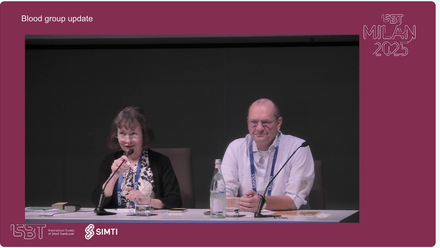The Diving deep into blood groups session included the following presentations:
1. Vanja Karamatic Crew: The new Er blood group system: Piezo and its role in RBC physiology
2. Gloria Wu: Elucidating the Blood Group Regulome
3. Camous Moslemi: A deep learning approach to the genetic prediction of blood group antigens
4. Gian-Andri Thun: Intriguing outcomes from Nanopore sequencing of two cryptic A3 samples: a case of blood group mosaicism and a novel regulatory variant in the ABO system
MODERATORS: Catherine Hyland and Frederik Banch Clausen
After the presentation, there was a questions and answers session of about 5 minutes, which is also included in the recording.
Abstract
Elucidating the blood group regulome
P Wu1, E McGowan1, M Möller1,2, Y Lee1, J Storry1,3, M Olsson1,3
1Department of Laboratory Medicine, Lund University, 2Dept. of Clinical Genetics and Pathology, 3Dept. of Clinical Immunology and Transfusion Medicine, Office for Medical Services, Lund, Sweden
Identifying blood groups correctly is essential in matching for blood transfusion and organ transplantation. Antigens are generated by variation in the blood group genes and expression levels of antigens on red blood cells (RBCs) are modulated by regulatory elements and the associated transcription factors (TFs). Antigen expression may be altered via mutations in the TF genes themselves or through changes in the TF motifs, the DNA sequences that TFs recognise and bind to. Variations in these motifs have previously been found to abolish or reduce expression levels of certain blood groups. A well-known example of abolishment is the Duffy blood group system where disruption of the GATA1 motif in the promoter region of the ACKR1 gene results in the Fy(a–b–) phenotype. Another example of weakened expression can be found in the ABO system where mutations in the GATA1 and RUNX1 motifs of ABO intron 1 lead to weak A or B antigen expression.
High throughput sequencing technology has facilitated genome-wide studies, enabling us to utilise public datasets and process those datasets through bioinformatic pipelines. We have developed and used a pipeline to identify erythroid TF motifs in blood group genes, and to validate predictions of gene regulatory elements in in vitro experiments to better understand the roles of TFs in the blood group regulome that lead to variable antigen expression levels.
Four GATA1 ChIP-seq datasets from adult primary erythroid cells were analysed using known GATA1 motifs in ACKR1, ABO and XG as positive controls. We identified 193 GATA1 binding motifs associated to blood group genes, including a motif in the RHD promoter which has been reported in a weak D case. In the CR1 gene of the Knops blood group system, multiple GATA1 motifs were predicted. Their potential association with the extremely reduced level of CR1 protein, resulting in the Helgeson phenotype, was further investigated since the underlying genetic mechanism was unclear. For the two GATA1 motifs in CR1 intron 4, in vitro assays confirmed that GATA1 enhances transcript levels in both wild-type sequences, compared to disrupted motifs where GATA1 binding was abolished. The minor allele of rs11117991:C disrupts the motif and, in Swedish and Thai rs11117991:C/C samples, CR1 mRNA and antigen expression levels were reduced in quantitative PCR and flow cytometry. These findings led to a proposed regulatory mechanism for the Helgeson phenotype.
Nevertheless, the 193 predicted GATA1 targets remain daunting to validate in vitro. To increase the credibility of predicted targets, we further expanded the datasets used to include: (1) other major erythroid TFs such as KLF1, RUNX1, NFE2; (2) histone markers such as H3K4me3, H3K4me1, H3K27ac which provide promoter and enhancer location indicators; and (3) chromatin accessibility (assay for transposase-accessible chromatin with sequencing; ATAC-seq). The inclusion of multiple TFs also allows us to study the interactions and relationships between TFs.
In conclusion, layering sequencing data for TFs, histone markers and open chromatin regions allows us to study the regulome in a systematic manner. For blood groups with observed quantitative polymorphism, these predicted targets may facilitate the search for the mechanisms underlying antigen expression variability.





